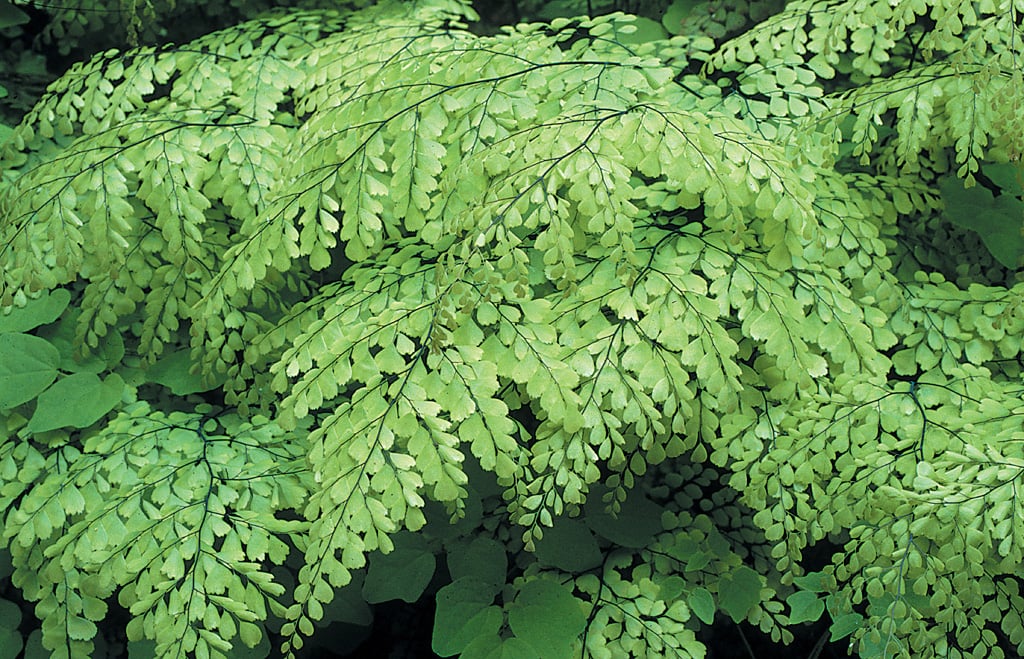

Contributor
- Topics: Archive

Shade is a shifty character, with a number of elusive and subjective descriptors, most commonly: light, partial, full, dappled, open, and deep. But what do these terms really mean? Every gardener is likely to contend with a range of distinct light levels found around the garden—whether beneath a heavy tree canopy or in an open area on the north side of the house. A regional perspective matters a good deal: what one gardener might view as full sun in the Pacific Northwest could be considered partial shade in Southern California. This year, Great Plant Picks tackles the question of plants that thrive in shade in our region, as experienced by gardeners in the Northwest, with the 2012 theme: Made in the Shade.
Great Plant Picks (GPP) is an educational program administered by the Elisabeth C Miller Botanical Garden in Seattle. GPP is developing a comprehensive palette of outstanding plants for the maritime Pacific Northwest landscape. The program depends upon the expertise of professional horticulturists from botanic gardens and nurseries and the experience of designers in Oregon, Washington, and British Columbia to select plants that are best suited for that area. There are now over 850 GPP selections, many of which will thrive in some degree of shade.
Many plants have adapted to various levels of shade; a few grow best under only one type of shade, but others thrive under various degrees of light. To help sort it all out, the GPP team has established concise definitions for the various degrees of shade and an assortment of plants that will thrive in each of those conditions.
Light Shade
Light shade offers conditions for the broadest range of plants to thrive. These areas receive about four to six hours of direct sunlight every day. This light intensity allows for many shade-tolerant plants to flower at their peak, including exceptional cultivars of woody plants such as witch hazel (Hamamelis), Hydrangea, mountain laurel (Kalmia), Magnolia, Pieris, Rhododendron, and Stewartia, and herbaceous perennials like barrenwort (Epimedium), Helleborus, Primula, and Trillium. The witch hazels, for instance, are cherished for their exquisitely fragrant, spidery flowers that appear during winter. One vigorous witch hazel selection, H. xintermedia ‘Arnold Promise’, has large, clear yellow flowers and reddish centers and is a particularly prolific bloomer.
The popularity phenomenon of hybrid hellebores (Helleborus xhybridus) expands each year in the Pacific Northwest, and it is easy to see why. This charismatic, winter-blooming perennial features nodding blossoms of pure white, glowing yellow, pink, rose, black purple, or bright apple green, bringing cheer to gray, rainy days and lifting the spirits of many gardeners throughout the region.

A number of hydrangeas are perfect for light shade and provide a floral focal point in the summer landscape. The lovely Swiss lacecap cultivar Hydrangea macrophylla ‘Blaumeise’ is laden with huge blue violet flowers, while H. macrophylla ‘Amethyst’ is an excellent, classic mophead hydrangea, with clusters of pale pink to pale purple flowers. The old cultivar H. macrophylla ‘Mariesii’ is one of the best lacecap types, with a profusion of delicate and graceful, pale lavender blue florets surrounding a center of small lacey flowers of a deeper lavender purple.

Open Shade
Open shade and light shade are often thought to be interchangeable designations, but there are distinct differences between them. An area of open shade is fully exposed to the sky but with little or no direct sunlight. This usually occurs when a structure or building blocks any sunlight, but there is no foliage canopy above to block the sun. This is one of the best locations to grow plants with golden foliage; their leaves remain richly colored, with no risk of burning from intense sunlight. Golden full moon maple (Acer shirasawanum ‘Aureum’) is a first-rate and highly sought-after small tree with golden foliage. In mid-spring, the buds open to reveal intense, bright lemon yellow leaves. This glowing display is dazzling during the typically gray days of spring. As the leaves mature, their color softens to chartreuse in early summer.
Hostas (Hosta) thrive in open shade, with robust leafy growth and plentiful late-summer blooms. A number of cultivars have been selected for 2012, including an assortment of sizes and leaf colors. On the smaller side is ‘Red October’—quite distinctive with its red petioles supporting blue green leaves. ‘Halcyon’ and ‘Blue Angel’, with strikingly blue leaves, reach two feet and three feet tall, respectively. Three selections sport leaves with white margins and green centers, all medium in size: ‘Francee’, ‘Minuteman’, and ‘Patriot’. In the same size category, but with the leaf coloration reversed, is ‘Loyalist’.


Dappled Shade
Gardening under conifers is a way of life in the Northwest. One of the best woodland shade conditions is dappled light, where the ground plane receives about two to three hours of sunlight filtered through the branches of the canopy above. When you look up into the canopy, between one-quarter and one-third of the sky remains visible through the foliage. Although many woodland favorites, such as rhododendrons, grow well here, their flowering is reduced due to the limited amount of sunlight reaching them. Consequently, foliage and good design play a significant role in creating a beautiful woodland garden.
Conifers are often limbed up, resulting in the need for a lower canopy of medium and small trees to add interest and establish a human scale in the landscape. Maples can be a great choice for this purpose: Acer triflorum offers interesting rough bark and great fall color, even in the shade; A. tegmentosum ‘Joe Witt’ brightens the area with brilliant green bark heavily striped with chalky white. For flowers and fruit in such situations, the beautifully layered branches of Cornus kousa var. chinensis ‘Milky Way’ are covered with starry white flowers in early summer and dangling red, strawberry-like fruits in early fall.

Ferns grow exceedingly well in dappled shade. One of the most sought-after in recent years is Himalayan maidenhair fern (Adiantum venustum), a gentle groundcover that spreads slowly. Its delicate fronds have an airy appearance; perhaps most enchanting is the manner in which the small fronds unfurl in late winter, with a warm, bronze blush that matures to a fresh spring green. Japanese painted fern (Athyrium niponicum var. pictum) brightens up dappled corners with its dramatic foliage: a range of silvers and reds are overlaid on the green fronds, making each leaf a work of art, according to GPP selection committee member Maurice Horn, of Joy Creek Nursery.

Deep Shade
It is difficult to separate deep shade from the dry conditions that often accompany it. This type of shade is usually the result of an almost impenetrable overhead canopy of trees, permitting less than one-quarter of the sky to be visible; little or no direct sunlight reaches the ground. Such a dense canopy of trees will naturally have a dense root system that competes for any moisture in the soil. Few plants grow well in this situation, but there are several GPP recommendations that are tough enough to survive. Foliage rules here rather than flowers, so it is best to focus on plants with appealing leaves or a striking form.
Several native plants are well equipped to thrive in dry shade. Cascade Oregon grape (Mahonia nervosa) is a low, loose groundcover with pinnately compound, emerald-green leaves, the leaflets being spiny, coarse, and evergreen. Our western wild ginger (Asarum caudatum) is an understory plant with bold, heart-shaped leaves that are fully evergreen and release a spicy, ginger-and-citrus fragrance when crushed. Its European counterpart (A. europaeum) has distinctive, kidney-shaped leaves that are also evergreen and a glossy dark green. The flowers of both are distinctive; watch for them peeking out from among the leaves in late winter.

For some height, add the reliable Japanese aralia (Fatsia japonica), with shiny, evergreen, palmate leaves on shrubs that will reach five feet or more in height, even in deep shade. The lobed leaves can reach sixteen inches across and provide valuable textural contrast in the shade garden. If you like something a little weird, try the curious XFatshedera lizei ‘Anne-mieke’, a rare hybrid between Japanese aralia and English ivy (Hedera helix). This vine-like shrub adds a subdued, golden yellow color to the deep shade garden, with glossy, dark green, eight-inch-wide leaves that are splashed with two-toned gold in the center. When happy, it can produce small clusters of white flowers in the fall, but don’t worry about unwanted seedlings, as it is completely sterile.

All of these plants and more can be found on the Great Plant Picks website: www.greatplantpicks.org. The website has recently been completely revised and will be launched in time for the Northwest Flower and Garden Show, in February 2012. New features have been added to help gardeners find useful lists of plants for difficult situations like shade; gardeners will also be able to create their own unique lists of plants for their specific cultural conditions and landscape needs.
Great Plant Picks for Made in the Shade
*new for 2012
Light Shade
Acer griseum (2-9, 14-21)
—paperbark maple
Acer palmatum ‘Katsura’ (2-10, 12, 14-24)
—Japanese maple
Aesculus parviflora
—bottlebrush buckeye
Aster divaricatus (now Symphyotrichum divaricatus) (1-10, 14-21)
—white wood aster
Athyrium filix-femina ‘Frizelliae’ (1-9, 14-24)
—tatting fern
Athyrium ‘Ghost’ (1-9, 14-24)
—ghost fern
Campanula lactiflora ‘Prichard’s Variety’ (1-9, 14-24)
—milky bellflower
Campanula poscharskyana ‘Blue Waterfall’ (1-12, 14-24)
—Serbian bellflower
Cornus controversa ‘June Snow’ (4-9, 14, 18, 19)
—giant dogwood
Corylopsis spicata (3b-7, 14-17)
—spike winterhazel
Enkianthus campanulatus ‘Red Bells’ (2-9, 14-21)
—enkianthus
Epimedium ‘Yubae’ (syn. ‘Rose Queen’) (2-9, 14-17)
—hybrid epimedium
Gentiana asclepiadea (2-6, 14-17)
—willow gentian
Hamamelis xintermedia ‘Jelena’ (3-7, 15-17)
—hybrid witch hazel
*Hosta ‘Gold Standard’ (1-10, 14-21)
—hosta
*Hosta ‘Halcyon’ (1-10, 14-21)
—hosta
*Hosta ‘Praying Hands’ (1-10, 14-21)
—hosta
*Hosta sieboldiana var. elegans (1-10, 14-21)
—hosta
Hydrangea anomala subsp. petiolaris (2-21)
—climbing hydrangea
Hydrangea macrophylla ‘Merritt’s Supreme’ (3b-9, 14-24)
—mophead hydrangea
Hydrangea paniculata ‘Tardiva’ (1-21)
—panicle hydrangea
Leptinella squalida ‘Platt’s Black’
—brass buttons
Magnolia sieboldii (4-9, 14-24)
—Oyama magnolia
Omphalodes verna (2-9, 14-21)
—creeping forget-me-not
Pieris japonica ‘Sarabande’ (2b-9, 14-17)
—pieris, lily-of-the-valley shrub
Pieris japonica ‘White Cascade’ (2b-9, 14-17)
—pieris, lily-of-the-valley shrub
Primula ‘Guinevere’ (1-24)
—polyanthus primrose
Primula japonica (2-6, 15-17)
—candelabra primula
Pulmonaria ‘Benediction’ (1-9, 14-17)
—lungwort
Rhododendron ‘Blue Boy’
—hybrid rhododendron
Rhododendron ‘Hachmann’s Charmant’
—hybrid rhododendron
Rhododendron schlippenbachii (3-7, 14-17)
—royal azalea
Sambucus nigra f. laciniata (2-7, 14-17)
—cutleaf black elder
Stachyurus praecox (4-6, 14-17)
—stachyurus
Stewartia pseudocamellia (4-6, 14-17, 20, 21)
—Japanese stewartia
Trillium grandiflorum (1-6)
—great white trillium, white wakerobin
Trillium chloropetalum (4-9, 14-17)
—giant trillium
Trillium ovatum (2-7, 14-17)
—coast trillium
Tsuga diversifolia (2-7, 17)
—northern Japanese hemlock
*Vancouveria hexandra (4-7, 14-17)
—inside-out flower
Open Shade
Acanthus caroli-alexandri
—bear’s breeches
Acer crataegifolium ‘Veitchii’ (3-6, 14-17)
—variegated hawthorn maple
Actinidia kolomikta (male form) (1-9, 14-17)
—variegated kiwi vine
Asplenium trichomanes (2-6)
—maidenhair spleenwort
Athyrium otophorum (3-9, 14-24)
—eared lady fern
Begonia grandis subsp. evansiana (3-24)
—hardy begonia
Camellia williamsii ‘Donation’ (4-9, 12, 14-24)
—hybrid camellia
Cardamine trifolia
—three-leaf cardamine
Carex oshimensis ‘Evergold’ (3-9, 14-24)
—variegated Japanese sedge
Cephalotaxus harringtonia (4-9, 14-17)
—cowtail pine, plum yew
Daphne odora ‘Aureomarginata’ (4-10, 12, 14-24)
—variegated winter daphne
Darmera peltata ‘Nana’ (2-7, 14-20)
—dwarf umbrella plant
Dicentra ‘Luxuriant’ (1-9, 14-24)
—fringed bleeding heart
*Disporum flavens
—fairy bells
Dryopteris wallichiana (4-6, 14-17)
—Wallich’s wood fern
*Hakonechloa macra ‘Beni-kaze’ (2b-9, 14-24)
—Japanese forest grass
Helleborus foetidus (2b-9, 14-24)
—stinking hellebore
Lathyrus vernus
—spring vetch, spring bush pea
Osmunda regalis ‘Purpurascens’ (1-9, 14-17)
—purple-tinged royal fern
Rodgersia podophylla (2-9, 14-17)
—mayapple rodgersia
Sanguinaria canadensis f. multiplex
—double-flowered bloodroot
Saxifraga ‘Primuloides’
—miniature London pride
Smilacina racemosa
—false Solomon’s seal
Tricyrtis ‘Tojen’
—toad lily
Dappled Shade
Acer circinatum ‘Monroe’ (2b-6, 14-17)
—cutleaf vine maple
Actaea racemosa (syn. Cimifuga racemosa) (1-7, 17)
—black snakeroot
Arisaema triphyllum (1-6)
—Jack-in-the-pulpit
Arisarum proboscideum
—mouse plant
*Diphylleia cymosa
—umbrella leaf
Disporopsis pernyi
—evergreen Solomon’s seal
Fargesia murielae
—umbrella bamboo
Phyllostachys nigra
—black bamboo, blackstem bamboo
Polystichum munitum (2-9, 14-24)
—sword fern
Polystichum polyblepharum (4-9, 14-24)
—Japanese tassel fern
Pulmonaria longifolia subsp. cevennensis (1-9, 14-17)
—longleaf lungwort
Sequoia sempervirens (4-9, 14-24)
—coast redwood
Shibataea kumasasa
—zig-zag bamboo
Tsuga canadensis ‘Pendula’ (2-7, 17)
—Sargent’s weeping hemlock
Deep Shade
Adiantum aleuticum (1-7, 14-21)
—western maidenhair fern
Asarum caudatum (4-6, 14-24)
—western wild ginger
Beesia deltophylla
—beesia
Blechnum spicant (2b-7, 14-19, 24)
—deer fern
Elaeagnus pungens ‘Maculata’ (4-24)
—golden elaeagnus
XFatshedera lizei ‘Annemieke’ (4-10, 12-24)
—golden variegated fatshedera
Fatsia japonica (4-9, 14-24)
—Japanese fatsia
Gymnocarpium disjunctum (sold as G. dryopteris)
—common oak fern
Osmanthus burkwoodii (4-9, 14-17)
—hybrid sweet olive
Oxalis oregana (evergreen form) (4-9, 14-24)
—evergreen redwood sorrel
Sarcococca ruscifolia (4-9, 14-24)
—sweetbox
All selections in the Great Plant Picks have been chosen for their suitability in USDA hardiness zones 7 and 8, which covers most of the Pacific Northwest, west of the Cascades. In the list above, zone numbers in parentheses refer to Sunset zones (when available) in the latest Sunset Western Garden Book, and have been provided as an aid for readers beyond the Northwest. Plants may not perform equally well in all of the Sunset zones noted. To learn more about the 2012 Great Plant Picks and the more than 800 plants picked to date, please visit the website at www.greatplantpicks.org.
Share:
Social Media
Garden Futurist Podcast
Most Popular
Videos
Topics
Related Posts

Ground Up Science for Greener Cities with Garden Futurist Dr. Alessandro Ossola
Spring 2023 Listen to the Podcast here. Alessandro Ossola is a scientist who gets very excited about the challenge of climate change allowing for an

Readying Urban Forests for Climate Realities with Garden Futurist Dr. Greg McPherson
Winter 2023 Listen to the Podcast here. “Going from the mow and blow to a more horticulturally knowledgeable approach to maintaining the landscape. And that

Low Maintenance Gardens – Better for Pollinators and People
Autumn 2022 “I come out every day. It’s therapy, my meditation.” Janet’s young garden transformed from overgrown, invasive plants to mostly natives. The dailiness of

Invasive Plants Are Still Being Sold: Preventing Noxious Weeds in Your Landscape
Autumn 2022 With so many beautiful ornamental plant species and cultivars throughout California and the Pacific Northwest, how do you decide which ones to include










Responses